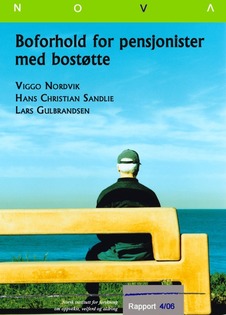| dc.contributor.author | Sandlie, Hans Christian | |
| dc.contributor.author | Gulbrandsen, Lars Petter | |
| dc.contributor.author | Nordvik, Viggo | |
| dc.date.accessioned | 2020-06-07T21:05:14Z | |
| dc.date.accessioned | 2021-04-29T13:50:56Z | |
| dc.date.available | 2020-06-07T21:05:14Z | |
| dc.date.available | 2021-04-29T13:50:56Z | |
| dc.date.issued | 2006 | |
| dc.identifier.isbn | 82-7894-232-3 | |
| dc.identifier.issn | 0808-5013 | |
| dc.identifier.uri | https://hdl.handle.net/20.500.12199/3227 | |
| dc.description.abstract | Housing allowances form an important part of the Norwegian housing policy. The allowances cover part of the housing expenses and they are meant to stimulate targeted households to obtain or retain a level of housing consumption in excess of what would otherwise have been chosen. In addition, the housing allowances shall even out some of the inequalities between households with pensions as their main source of income. The target groups are families with children and pensioners, both old age and disabled pensioners. This report describes the housing conditions for pensioners. To be eligible for housing allowances a household should be living in a housing unit that satisfies a set of minimum housing standard requirements. Note that both tenants and owner-occupiers are covered by the housing allowance system. The Norwegian housing allowances have special rules which apply to pensioners with an income below 130 percent of the minimum pension. The most important of these are that they are exempted from the minimum housing standard requirements. Our report describes the housing conditions of pensioners receiving housing allowances, using a data set based on the 2001 census. Among the empirical results it is worth mentioning that there are not any large differences between pensioners on housing allowances with income above and below the 130 percent limit. Around 10 percent of those with an income below 130 percent of the minimum pension have a housing unit which is smaller than 40 square meters. The corresponding share among receivers of housing allowances with a pension income above the 130 percent limit is 7 percent. The frequency of receivers of housing allowances with a pension income, living in rental housing is larger among pensioners receiving housing allowances than among other pensioners - also at a comparable level of income. Very few (less than 3 percent) receivers live in housing units lacking basic functions as a wc, a bathroom or a kitchen of their own. | en |
| dc.description.abstract | Bostøtten er et sentralt virkemiddel i den norske boligpolitikken. Gjennom å dekke en del av boutgiftene skal bostøtten stimulere hushold til å velge bedre boliger enn det de ellers ville ha gjort. Bostøtten setter mottakerne i stand til å beholde sin bolig, også om inntektene skulle reduseres eller om boutgiftene skulle øke. Ved at størrelsen på bostøtten avhenger av nivået på boutgiftene er den en likviditetsstøtte. I tillegg til at bostøtten skal påvirke husholdenes valg av bolig, er det også et mål at den skal bidra til å jevne ut inntektsforskjeller mellom grupper av pensjonister. Bostøtten er rettet mot barnefamilier og trygdede. I denne rapporten undersøker vi boforholdene til pensjonister som har bostøtte. Beskrivelsene baserer seg primært på data fra Folke- og boligtellingen fra 2001. | no_NB |
| dc.publisher | Oslo Metropolitan University - OsloMet: NOVA | |
| dc.relation.ispartofseries | NOVA Rapport 4/06 | |
| dc.subject | NOVA | |
| dc.title | Boforhold for pensjonister med bostøtte | no_NB |
| dc.type | Report | |
| fagarkivet.author.link | https://www.oslomet.no/om/ansatt/hcsan | |
| fagarkivet.author.link | https://www.oslomet.no/om/ansatt/larsg | |
| fagarkivet.author.link | https://www.oslomet.no/om/ansatt/vnord | |
| fagarkivet.source.pagenumber | 148 | |
